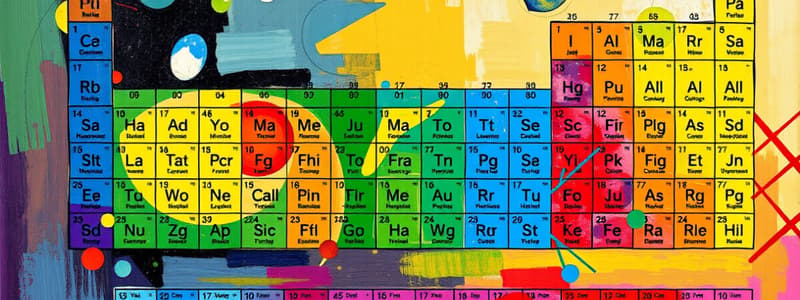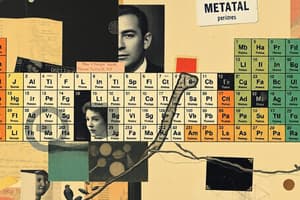Podcast
Questions and Answers
Where on the Periodic Table are the most metallic elements located?
Where on the Periodic Table are the most metallic elements located?
Bottom left
What are nonmetals?
What are nonmetals?
Nonmetals are elements that have no metallic properties.
Where on the Periodic Table are nonmetals located?
Where on the Periodic Table are nonmetals located?
Nonmetals are located on the right.
At room temperature, most nonmetals are in which state of matter?
At room temperature, most nonmetals are in which state of matter?
In which periods are metals located on the Periodic Table?
In which periods are metals located on the Periodic Table?
List the alkali metals.
List the alkali metals.
How is the Periodic Table arranged using atomic numbers?
How is the Periodic Table arranged using atomic numbers?
Which 4 factors did Mendeleev use to arrange his Periodic Table?
Which 4 factors did Mendeleev use to arrange his Periodic Table?
Define periodic table.
Define periodic table.
What is the definition of atomic number?
What is the definition of atomic number?
How did Moseley organize his periodic table?
How did Moseley organize his periodic table?
What are groups on the periodic table?
What are groups on the periodic table?
What are periods on the periodic table?
What are periods on the periodic table?
Explain how scientists are able to determine a synthetic element's properties.
Explain how scientists are able to determine a synthetic element's properties.
Define luster.
Define luster.
Define conductivity.
Define conductivity.
Define ductility.
Define ductility.
Define malleability.
Define malleability.
Alkali metals are in which group?
Alkali metals are in which group?
Do alkali metals react quickly or slowly with other elements?
Do alkali metals react quickly or slowly with other elements?
Are alkali metals found in nature as elements, in compounds, or both?
Are alkali metals found in nature as elements, in compounds, or both?
What type of appearance do alkali metals have?
What type of appearance do alkali metals have?
Are alkali metals soft or hard?
Are alkali metals soft or hard?
Describe the density of alkali metals.
Describe the density of alkali metals.
What type of metals have the lowest densities?
What type of metals have the lowest densities?
How are alkali metals and alkaline earth metals different?
How are alkali metals and alkaline earth metals different?
How are alkali metals and alkaline earth metals similar?
How are alkali metals and alkaline earth metals similar?
Where on the Periodic Table are Transition Elements located?
Where on the Periodic Table are Transition Elements located?
What are the properties of transition elements?
What are the properties of transition elements?
What are lanthanides used for?
What are lanthanides used for?
What are actinides used for?
What are actinides used for?
Describe the arrangement of metals in the periodic table in terms of their properties.
Describe the arrangement of metals in the periodic table in terms of their properties.
The human body is made up of mostly (metals, nonmetals)?
The human body is made up of mostly (metals, nonmetals)?
96% of the mass of the human body is made up of what 4 elements?
96% of the mass of the human body is made up of what 4 elements?
What are nonmetals?
What are nonmetals?
Solid nonmetals have what type of surface?
Solid nonmetals have what type of surface?
What is the nonmetal that is in group 14?
What is the nonmetal that is in group 14?
What are the nonmetals that are in group 15?
What are the nonmetals that are in group 15?
What are the nonmetals that are in group 16?
What are the nonmetals that are in group 16?
In which group are the halogens?
In which group are the halogens?
What is the name of the group 17 elements?
What is the name of the group 17 elements?
Are halogens found in nature as elements, in compounds, or as both?
Are halogens found in nature as elements, in compounds, or as both?
With what type or types of elements do halogens react?
With what type or types of elements do halogens react?
What is the resulting compound called when a halogen reacts with a metal?
What is the resulting compound called when a halogen reacts with a metal?
As you move down the halogens group, what happens to the reactivity?
As you move down the halogens group, what happens to the reactivity?
As you move up the halogen group, what happens to the reactivity?
As you move up the halogen group, what happens to the reactivity?
In what group are the Noble Gases?
In what group are the Noble Gases?
What are the group 18 elements called?
What are the group 18 elements called?
Why weren't the noble gases included in Mendeleev's periodic table?
Why weren't the noble gases included in Mendeleev's periodic table?
Are noble gases found as elements, in compounds, or as both in nature?
Are noble gases found as elements, in compounds, or as both in nature?
Explain how hydrogen shows properties of both metals and nonmetals.
Explain how hydrogen shows properties of both metals and nonmetals.
Define metalloid.
Define metalloid.
How are metalloids like metals?
How are metalloids like metals?
How are metalloids like nonmetals?
How are metalloids like nonmetals?
Define semiconductor.
Define semiconductor.
How is a semiconductor useful?
How is a semiconductor useful?
Be able to tell an element's atomic number whether it's a metal, nonmetal, or metalloid; and which group and period it is in by using your foldable periodic table.
Be able to tell an element's atomic number whether it's a metal, nonmetal, or metalloid; and which group and period it is in by using your foldable periodic table.
Be able to list elements from each of the different groups (alkali, halogens, etc.) using your foldable periodic table.
Be able to list elements from each of the different groups (alkali, halogens, etc.) using your foldable periodic table.
In your own words, determine how the periodic table first was made and how it helps you.
In your own words, determine how the periodic table first was made and how it helps you.
Flashcards are hidden until you start studying
Study Notes
Periodic Table Basics
- Most metallic elements are found at the bottom left of the Periodic Table.
- Nonmetals have no metallic properties and are located on the right side.
- At room temperature, most nonmetals are gaseous.
Arrangement of Elements
- Metals are located in periods 2-7 on the Periodic Table.
- The atomic numbers of elements increase from left to right across periods.
- Mendeleev arranged the Periodic Table based on density, color, melting point, and atomic mass.
- Groups refer to columns, while periods refer to rows on the Periodic Table.
Definitions
- The periodic table is a chart of elements arranged by their physical and chemical properties.
- Atomic number refers to the number of protons in an atom's nucleus.
Contributions of Scientists
- Moseley organized the Periodic Table by increasing atomic numbers, enhancing accuracy.
Characteristics of Elements
- Synthetic elements’ properties are determined by examining similar elements in the same group and period.
- Luster is the ability to reflect light; conductivity refers to conducting heat and electricity; ductility is the ability to form thin wires; malleability describes the ability to be rolled into sheets.
Alkali Metals
- Alkali metals are located in Group 1; they react quickly with other elements and are found in compounds rather than as free elements.
- These metals exhibit a dull appearance, are soft, and possess the lowest densities among metals.
Alkali vs. Alkaline Earth Metals
- Alkali metals are in Group 1, extremely reactive, with the lowest densities.
- Alkaline earth metals are in Group 2, very reactive, but with higher densities than alkali metals.
- Both groups only occur in nature as compounds and are characterized by their softness and silvery color.
Transition Elements
- Transition elements are located in groups 3-12.
- They are known for their great strength, high melting points, high densities, and lower reactivity compared to other metals.
Lanthanides and Actinides
- Lanthanides are used for strong magnets.
- Actinides serve as fuel in nuclear reactions.
Nonmetals
- Nonmetals primarily make up the human body, composed mainly of oxygen, nitrogen, carbon, and hydrogen.
- Solid nonmetals typically have a dull surface and are characterized by a lack of luster.
Groups of Nonmetals
- Group 14 contains carbon; Group 15 includes nitrogen and phosphorus; Group 16 features oxygen, sulfur, and selenium.
- Halogens are found in Group 17, and they react with metals and nonmetals to form salts. Reactivity decreases as you move down this group, while it increases moving up.
Noble Gases
- Noble gases, located in Group 18, are discovered after Mendeleev's time; they only exist as individual elements and not in compounds.
- Hydrogen displays both metallic and nonmetallic properties under various conditions.
Metalloids and Semiconductors
- Metalloids possess characteristics of both metals and nonmetals, conducting electricity at high temperatures and insulating at lower temperatures.
- Semiconductors conduct electricity, making them useful in electronics, functioning well at high temperatures yet insulating at low temperatures.
Practical Skills with the Periodic Table
- Using a foldable periodic table helps identify an element’s atomic number, classify it as metal, nonmetal, or metalloid, and determine its group and period.
- Familiarity with groups like alkali metals and halogens enhances understanding of elemental properties and behaviors.
Studying That Suits You
Use AI to generate personalized quizzes and flashcards to suit your learning preferences.




